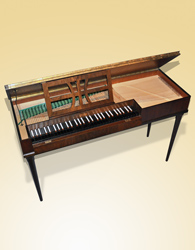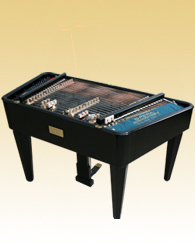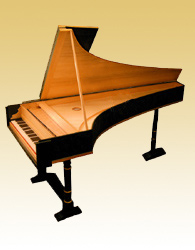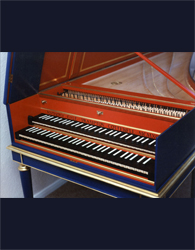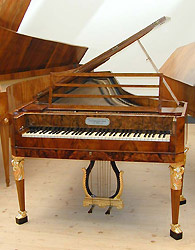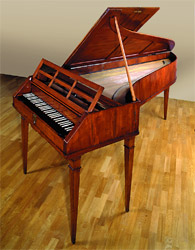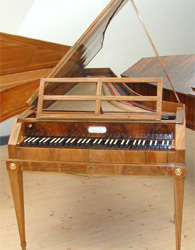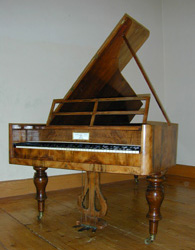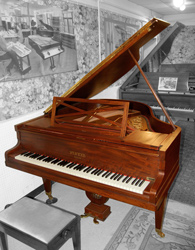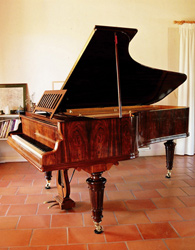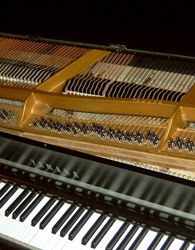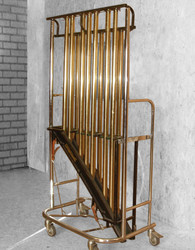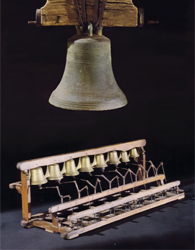We currently offer free instruments as part of two projects: "KIViR" (Keyboard Instrument Virtual Restoration) and “Bells and Carillons”.
The KIViR project contains ancestors of the piano (clavichord, cimbalom, harpsichord), historical pianoforte and pianos.
The Bells and Carillons project contains church bells, carillons and tubular bells.
Below is a detailed description of these.
KIViR instruments
Clavichord
Clavichord: Neupert
This is a physically modelled virtual copy of clavichord Neupert (1941) which is based on a "Modell Philipp Emanuel Bach". It was provided by the Kremsegg Schloss Museum (Kremsmünster, Austria).
The clavichord, invented in the early 14th Century, is a predecessor to the piano and to the more recent clavinet. It is a popular instrument for playing music from the Renaissance and Baroque period, but can in fact also be found in other more modern music styles such as in recordings by Oscar Peterson, Keith Jarrett, Tori Amos and The Beatles.
Cimbalom
Cimbalom: Kovács
This is a physically modelled virtual copy of cimbalom Balázs Kovács (2007).
The cimbalom belongs to the ancestor psaltery, quoted in the bible. The psaltery was later developed into different variants which differed in sound but were similar in their constructive concept. One of these, the cimbalom, was a constant member of gypsy orchestras. Legs and a damper pedal were soon added to the instrument and it reached the status of concert instrument in the 19th Century, thanks to Ferenc Erkel and Franz Liszt.
Contrarily to the piano, pressing down a key does not lift the corresponding damper. Hence, unless the pedal is depressed, all notes are immediately dampened.
Harpsichords
Harpsichord: Grimaldi
This is a physically modelled virtual copy of a harpsichord by Carlo Grimaldi dating from 1697, copied by Andrew Wooderson (Bexley, 2007). Typical of a short-scaled Italian instrument it has a crispness of attack and transparency of tone that makes it ideal for continuo use, and is also well suited to 17th and 18th Century Italian and German solo repertoire. Its two registers can be played separately or combined together.
Harpsichord: Blanchet
This is a physically modelled virtual copy of harpsichord François-Etienne Blanchet, "Château de Thoiry" (1733), copied by Anthony Gale (Frampton Cotterell, UK, 1993). It has a very delicate sound, inviting for inspiring musical moments from the baroque period representative by great masters such as Scarlatti, Bach and Händel.
Pianoforte
Pianoforte: Walter
This is a physically modelled virtual copy of an Anton Walter pianoforte.
Anton Walter (1752-1826) was an important and famous Viennese instrument builder. He was a friend of Wolfgang Amadeus Mozart who owned one of his instruments and often used it in concerts. Ludwig van Beethoven also belonged to those who often praised the solid quality. By improving the Viennese pianoforte action, Walter managed to build instruments with a slightly more powerful sound than that of his competitors. The instruments are often used today as models for the construction of authentic copies.
Pianoforte: Schöffstoss
This is a physically modelled virtual copy of pianoforte Donat Schöffstoss, 1812, recorded at Schloss Kremsegg, A-4550 Kremsmünster, Austria. Schöffstoss offered the delicate Viennese action which gives it a slightly gentler sound than the more sturdy English variants.
Pianoforte: Schmidt
This is a physically modelled virtual copy of pianoforte Johann Evangelist Schmidt, Salzburg about 1790, recorded at Handelhaus, D-06108, Halle, Germany. This hammerflügel variant became appreciated by the contemporaries because of its beautiful and even sound, its outside elegance and affordable price.
Pianoforte: Schantz
This is a physically modelled virtual copy of pianoforte Johann Schantz, Vienna, ca 1790, recorded at Schloss Kremsegg, A-4550 Kremsmünster, Austria. Like many other fortepianos of its period, it is very lightly constructed and has much smaller hammers and thinner strings than a modern piano. Beethoven described it as good and durable and he recommended them to his friends.
Pianoforte: Graf
This is a physically modelled virtual copy of pianoforte Conrad Graf, Vienna, 1826, recorded at Schloss Kremsegg, A-4550 Kremsmünster, Austria. The Graf pianofortes were held in high esteem, and soon were considered the greatest and most renowned in Vienna and throughout the empire. Beethoven was particularly fond of these.
Grand pianos
Grand piano: Pleyel
This is a physically modelled virtual copy of grand piano Pleyel, model F (1926). Chopin preferred to compose and perform on Pleyel pianos and it was also used by other major composers, such as Debussy, Ravel and Stravinsky. The Pleyel sound can be described as round, warm and sensual.
Grand piano: Erard
This is a physically modelled virtual copy of piano Sébastien Erard, a half grand (2 m), serial number 109 933 (1922). It has an extraordinary warm and coloured sound with lots of charm, and is equipped with a very delicate una corda pedal. We tried to be as close as possible to the original instrument, including some small "defaults" in the bass strings. The instrument suits naturally well for Liszt who loved playing on Erard.
Electro-acoustic
Electro-acoustic piano: CP-80
This is a physically modelled virtual copy of an electro-acoustic Yamaha CP-80, serial number 1982. The CP-80 was a very popular stage piano at the time (1976-1985) with a unique sound and with an authentic grand piano action. It was marketed by Yamaha as a touring friendly and electronically amplified variant of a grand piano. It was famous for its rock solid quality and considered by many as the "Rolls Royce" of the electro-acoustic pianos.
Bells and carillons
Tubular bells
This is a virtual copy of a Tubular bells.
The add-on is modelled after a Bergerault 18 Note concert chimes which is made of brass tubes of graded length that are tuned to a chromatic scale. The instrument appeared for the first time in England in the late 19th Century and is ever since part of major symphonic orchestras. The add-on includes 3 variants and has an extended note range: 5 octaves instead of the usual 1½ octave.
Church bells and carillons
This is a virtual copy of bells and a carillons that were recorded at the European Bell Institute.
The use of bells in the Christian church goes back to the early Middle Ages. A bell is an idiophone, that is, a musical instrument which produces a vibration. The bell is in fact one of the loudest of musical instruments. The sound has the power to bring many mixed feelings derived from our experiences connected to it: joy, happiness, grief, fear, relief, revelation, excitement, amazement.
Credits
We are grateful to...
... for their valuable contributions.
Special acknowledgments to the following instrument owners:
- C. Bechstein Digital, Germany (C. Bechstein DG)
- J. Blüthner Pianofortefabrik GmbH, Germany (Blüthner Model One grand piano)
- Grotrian Piano Company GmbH, Germany (Grotrian Concert Royal grand piano)
- Peter Karsten, Germany (Karsten collection)
- Daniel Parisot, France (Hamburg Steinway D)
- PETROF, spol. s r.o., Czech Republic (Ant. Petrof)
- Steingraeber & Söhne Piano Manufactory, Germany (Steingraeber E-272)
- Steinway & Sons, USA (New York Steinway D)
- Michel Armengot, France (CP-80)
- Paul Badura-Skoda, Austria (Walter)
- Robin Bigwood, UK (Grimaldi, François-Etienne Blanchet)
- Olivier Cussac, France (Rhodes MK1, Wurlitzer 200A, Clavinet D6)
- European Bell Institute, France (Bells)
- Luigi Gaggero, Italy (Cimbalom)
- Haendelhaus, Germany (Schmidt)
- Monique Niebisch, France (Sébastien Erard)
- Christophe Nebout, France (Pleyel model F)
- Orchestre du Capitole de Toulouse, France (Celesta, Glockenspiel, Marimba, Xylophone, Tubular bells)
- Toulouse les Orgues, France (Orgue du Gesu)
- Gilbert O'Sullivan, UK (Carl Bechstein)
- Kremsegg Schloss, Austria (Neupert, Schöffstoss, Schantz, Graf)
- Pascal Gaillard, France (Steel Drum)
- Marc Guilliou, France (Spacedrum, Hand Pand, Tank Drum)
- Klaus P. Rausch, Germany (Electra-piano, Pianet T)
Many thanks also to our customers and forum users who shared with us their valuable opinions and ideas.


